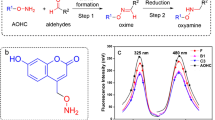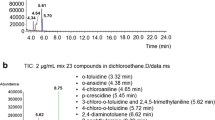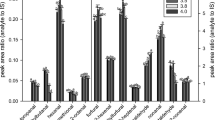Abstract
In this work, the determination of aldehydes in different tequila brands was carried out by high-performance liquid chromatography after derivatization with 2,4-dinitrophenylhydrazine. For the comparative purposes, two commercial brandies were also analyzed. The derivatization agent (50 μl of 3.5 mmol l−1 DNPH in HCl, 2 mol l−1) was added directly to the sample (500 μl) and dinitrophenylhydrazones formed were extracted with hexane. After evaporation of the solvent in nitrogen stream, the residues were dissolved in 100 μl of acetonitrile. The calibration standards were prepared from respective dinitrophenylhydrazones, following the same procedure as for beverage samples. Reversed phase chromatographic separation was achieved on Luna C18 column (250 mm×4.6 mm, 5 μm), using gradient elution (acetonitrile:water, from 68 to 80% of acetonitrile in 20 min) and a total flow rate 1 ml min−1. Spectrophotometric detection for furanic aldehydes was at 390 nm (for other aldehydes at 365 nm). The assignation of chromatographic peaks was accomplished by comparison of their relative retention times and UV/Vis spectra with those of external standards. The method of standard addition was also used. The aldehydes identified were 5-hydroxymethylfurfuraldehyde (t ret=4.1 min), formaldehyde (t ret=5.1 min), syringaldehyde (t ret=5.6 min), acetaldehyde (t ret=6.2 min), 2-furaldehyde (t ret=7.2 min) and 5-methylfurfuraldehyde (t ret=8.9 min). At least four chromatographic peaks with retention times higher than 12 min remained unidentified. The quantification results showed drastically higher concentrations of 2-furaldehyde and 5-methylfuraldehyde in tequilas as referred to brandies. Furthermore, 100% tequilas contained higher levels of these two compounds (for four brands analyzed, mean values 18.6 and 5.97 μg ml−1, respectively) as compared to the mixed brands (five brands analyzed, mean values 6.46 and 3.30 μg ml−1). The results obtained confirm that the profile of furanic aldehydes depends on the type of fructans contained in the raw material and also on heating treatment applied or not prior to fermentation. In contrast to other polysaccharides, inulin hydrolyzes at elevated temperature and the contribution of Maillard browning reactions increases the production of furanic compounds. Our results indicate that the levels of 2-furaldehyde and 5-methylfuraldehyde could be used for discrimination between 100% and mixed tequila brands.


Similar content being viewed by others
References
Rodriguez Madrera R, Blanco Gomis D, Mangas Alonso JJ (2003) J Agric Food Chem 51:7969–7973
Barroso CG, Rodríguez MC, Guillen DA, Perez-Bustamante JA (1996) J Chromatogr A 724:125–129
Canas S, Belchior AP, Spranger MI, Bruno-de-Sousa R (2003) J Sep Sci 26:496–502
Nascimento RF, Marques JC, Lima Neto BS, De Keukeleire D, Franco DW (1997) J Chromatogr 782:13–23
Quesada-Granados J, Villalon-Mir M, Lopez-Garcia-Serrana H, Lopez-Martinez MC (1995) Food Chem 52:203–208
Amdur OM, Doull J, Klaassen D (1991) Casarett and Doull's toxicology – the basic science of poison. New York, Mac Millan
Bauer-Chriostoph C, Christoph N, Aguilar-Cisneros BO, Lopez MG, Richling E, Rosmmann A, Schreider P (2003) Eur Food Res Technol 217:438–443
Panossian A, Mamikonyan G, Torosyan M, Gabrielyan E, Mkhitaryan S (2001) Anal Chem 73:4379–4383
Mangas J, Rodriguez R, Moreno J, Suarez B, Blanco D (1996) J Agric Food Chem 44:3303–3307
Mangas JJ, Rodriguez R, Moreno J, Suarez B, Blanco D (1997) J Agric Food Chem 45:4076–4079
Canas S, Leandro CM, Spranger MI, Belchior AP (1999) J Agric Food Chem 47:5023–5030
Cadahia E, Fernandez de Simon B, Jalocha J (2003) J Agric Food Chem 51:5923–5932
Quesada-Granados J, Villalon-Mir M, Lopez Serrana H, Lopez Martinez MC (1996) Food Chem 56:415–419
Aguilar-Cisneros BO, Lopez MG, Richling E, Heckel F, Schreier P (2002) J Agric Food Chem 50:7520–7523
Cedeno M (1995) Crit Rev Biotechnol 15:1–11
Mancilla-Margalli NA, Lopez MG (2002) J Agric Food Chem 50:806–812
Antal MJ Jr, Mok WS, Richards GN (1990) Carbohydr Res 199:91–109
Norma Oficial Mexicana NOM,-006-SCFI-1994, Bebidas alcohólicas – Tequila – Especificaciones
Matejicek D, Klejdus B, Mikes O, Sterbova D, Kuban V (2003) Anal Bioanal Chem 377:340–345
Blanco-Gomis D, Gutierrez-Alvarez MD, Sopena-Naredo L, Mangas-Alonso JJ (1991) Chromatographia 32:45–48
Albala-Hurtado S, Veciana-Nogues MT, Izquierdo-Pulido M, Vidal-Carou MC (1997) J Agric Food Chem 45:2128–2133
Kiridena W, Poole SK, Poole CF (1994) J Planar Chromatogr Mod TLC 7:273–277
Risner CH, Martin P (1994) J Chromatogr Sci 32:76–82
Takeda S, Wakida S, Yamane M, Higashi K (1994) Electrophoresis 15:1332–1334
Branderberger RH, Branderberger H (1993) In: Blau K, Halket J (eds) Handbook of derivatives for chromatography. Wiley, Chichester, pp 131–40
Munoz Rogriguez D, Wrobel K, Wrobel K (2005) Chem Anal (Warsaw) (in press)
Lehtonen PJ, Keller LA, Ali-Matilla ET (1999) Z Lebensm Unters Fosch A 208:413–417
Alonso-Salces RM, Guyot S, Herrero C, Berrueta LA, Drilleau JF, Gallo B, Vicente F (2004) Anal Bioanal Chem 379:464–475
de Costa RS, Santos SRB, Almeida LF, Nascimento RF, Pontes MJC, Lima RAC, Simoes SS, Araujo MCU (2004) Microchem J 78:27–33
Author information
Authors and Affiliations
Corresponding author
Rights and permissions
About this article
Cite this article
Rodríguez, D.M., Wrobel, K. & Wrobel, K. Determination of aldehydes in tequila by high-performance liquid chromatography with 2,4-dinitrophenylhydrazine derivatization. Eur Food Res Technol 221, 798–802 (2005). https://doi.org/10.1007/s00217-005-0038-6
Received:
Revised:
Accepted:
Published:
Issue Date:
DOI: https://doi.org/10.1007/s00217-005-0038-6




